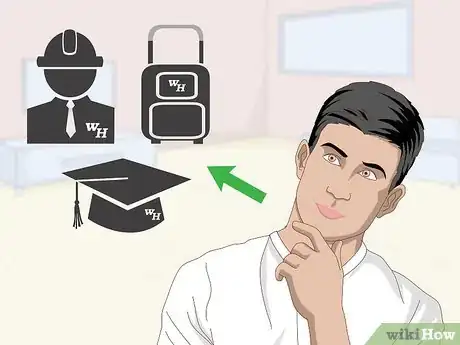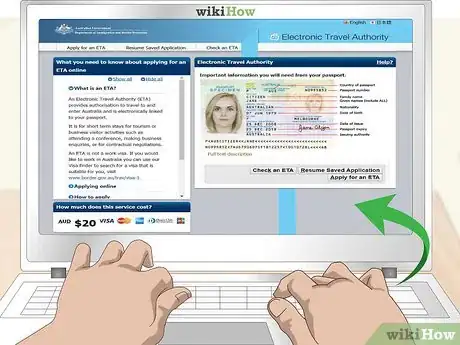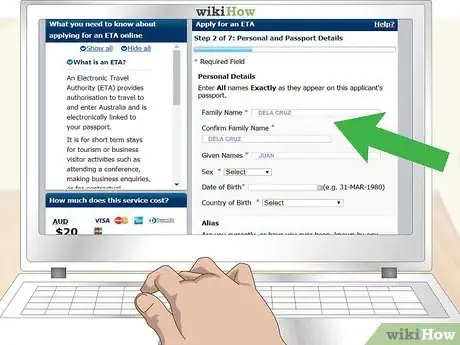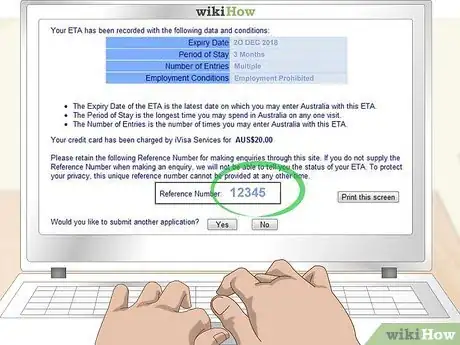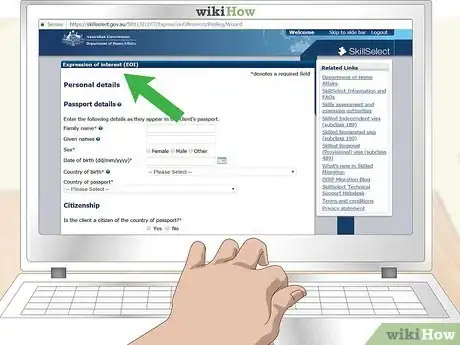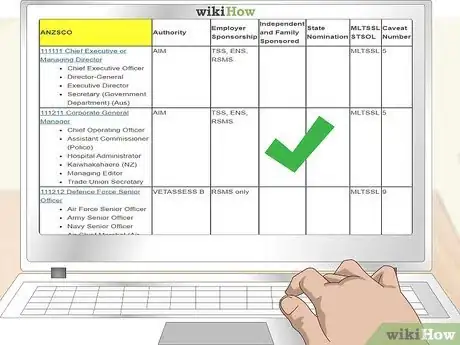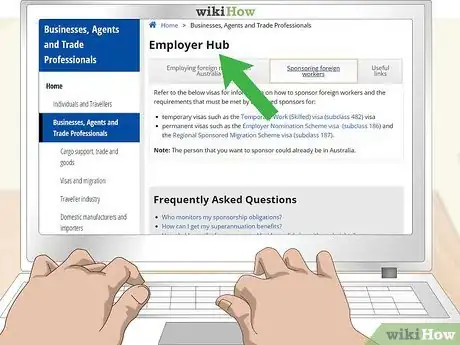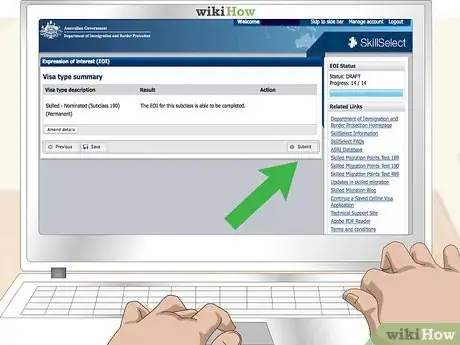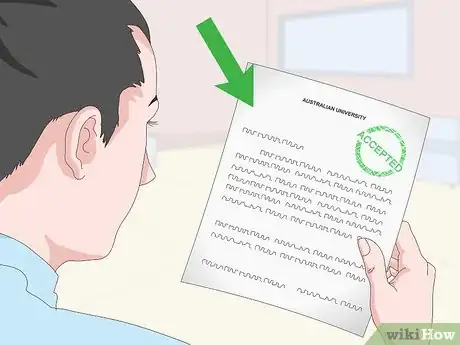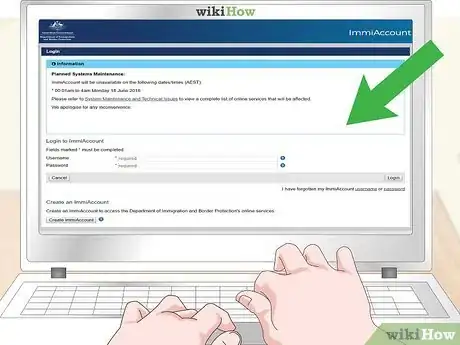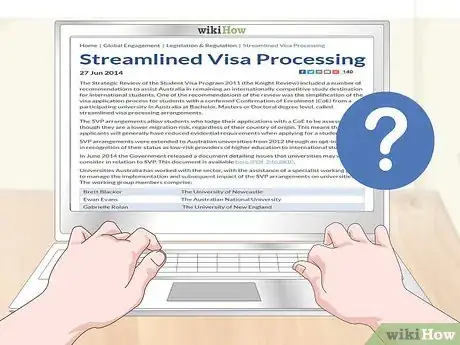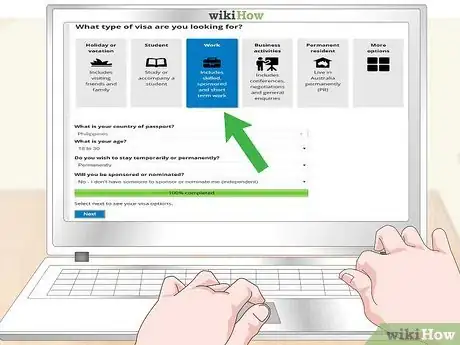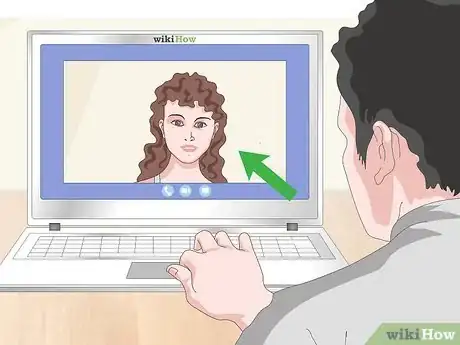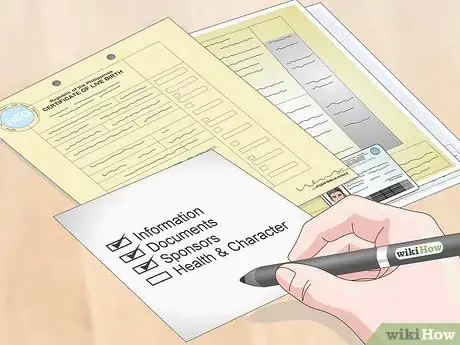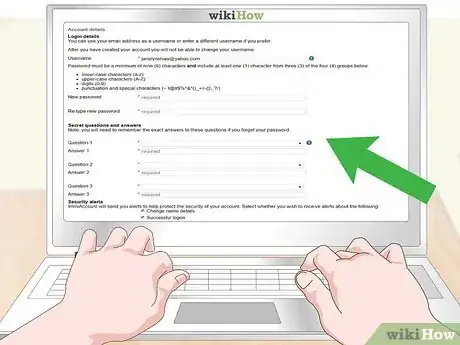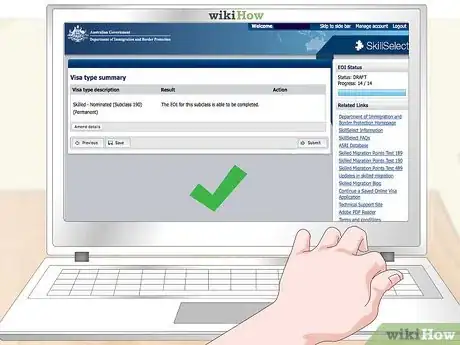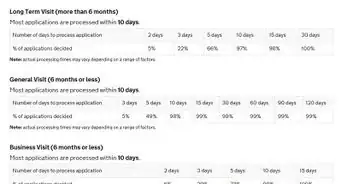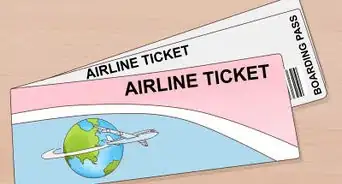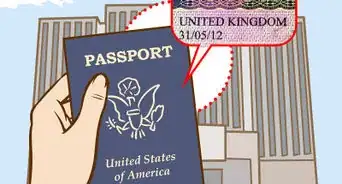This article was co-authored by Jennifer Mueller, JD. Jennifer Mueller is an in-house legal expert at wikiHow. Jennifer reviews, fact-checks, and evaluates wikiHow's legal content to ensure thoroughness and accuracy. She received her JD from Indiana University Maurer School of Law in 2006.
There are 12 references cited in this article, which can be found at the bottom of the page.
This article has been viewed 35,820 times.
Whether you want to visit Australia for a short vacation or plan to move and live there permanently, you must get a visa before you can enter the country. Anyone who arrives in Australia without valid documentation may be refused entry and detained until their identity and other information is confirmed. However, you can avoid this inconvenience by making sure your visa and other travel documents are in order before you attempt to enter the country. The visa application process in Australia is handled by the Department of Immigration and Border Protection.[1]
Steps
Visiting Australia
-
1Determine which visa is right for you. Australia has a number of different visas available depending on the reason for your visit.
- For example, if you are planning on being in the country for less than three months, you can apply for a visitor visa. If you're planning on conducting business in Australia, but will be in the country less than three months, you may need a short validity business visa.[2]
- If you get a visitor visa, you may visit Australia as many times as you want during a 12 month period from the date your visa is granted. However, you cannot stay any longer than three months on each visit. You can't get a job while on a visitor visa, or study for more than three months, but you can conduct business activities such as negotiating contracts or attending conferences.[3]
- Generally, the visitor visas are available for people coming to Australia as tourists. While visiting, holders of visitor visas may participate in certain business activities.[4]
- Visitors to Australia from certain European countries may be eligible for the eVisitor visa, which is available free of charge and allows the holder to visit Australia for up to three months at a time over the course of a year.[5]
- If you want to stay for more than three months, you might be eligible for a long-stay visitor visa, which allows you to stay in Australia up to 12 months. You must be a passport holder from an eligible country. Eligible countries include the U.S. and Canada as well as many South American, African, Asian and European countries.
- Australia has other specific visas that may be more appropriate for you if, for example, you are traveling to Australia to seek medical treatment or to visit family.[6]
-
2Get your visa application. The easiest way to get a visa application is to visit the Australia Electronic Travel Authority webpage.
- The ETA system only can be used if you are outside Australia. In addition, you can only use the ETA system if you do not have tuberculosis and have not been convicted of any crimes for which you were sentenced for a total combined period of 12 months or more.[7]
- You can apply for a visa online if you live in the United States, Canada, or a few other countries.[8] If you hold a passport from another country, you can get a visa application through a travel agent, airline, or Australian visa office.[9]
Advertisement -
3Complete your visa application. If you are applying online, you must have your passport, email address, and a credit card to complete the application.[10]
-
4Submit your application to the DIBP. Once you've completed your application, you must submit it and pay the processing fee.
- The online ETA system costs AUD $20, and accepts all major credit cards.[11] The service charge is non-refundable, so you won't get your money back even if Australia refuses to grant your visa.[12]
- If you aren't eligible to use the ETA or eVisitor system, expect to pay fees of around AUD $135 for a visitor's visa application.[13]
-
5Receive confirmation of processing. When you submit your application, you will receive a reference code to use in any follow-ups.
- If you are using the online ETA system, you will receive a reference number as soon as you submit your application. It typically takes around 30 seconds for your application to be approved after you complete the submission process and enter your credit card information.[14] The longest it will take to process your application if you're using the ETA system is 12 hours.[15]
Working in Australia
-
1Decide if you want a temporary or permanent visa. Temporary visas last anywhere from one day up to four years and allow you to work for an Australian employer, while permanent visas have no time limitation.
-
2Check the skilled occupations list. If you are applying for certain types of work visas you must choose the occupation from Australia's skilled occupations list that best describes the type of work you do.
- Skilled occupations include construction and engineering occupations, accountants, nurses and medical assistants, physicians, medical specialists, architects, and lawyers.
-
3Submit an Expression of Interest. Australia has an online service called SkillSelect where skilled workers can enter details about their work skills and indicate their interest in migrating to Australia to work.
- There is no fee to submit an EOI through SkillSelect.
- Australian employers or the government of an Australian state or territory might find your information and nominate you for a visa.
- Since different types of visas have different eligibility requirements, you should review the types of visas before you submit your EOI and make sure you're expressing interest only in types of visas for which you are eligible.[16]
- You also could be invited by the Australian government to complete a visa application.
- Using SkillSelect is mandatory for certain types of visas such as the skilled-independent and skilled-nominated visas.[17]
- If you submit an EOI and are subsequently invited to apply for a skilled migration visa, you have 60 days from the date of your invitation to submit a visa application.[18]
- To submit an EOI, you must meet the English language requirement and be able to demonstrate that you have taken an English language test within 36 months before you applied for your work visa.[19]
-
4Complete a skills assessment. Some skilled occupations require a skills assessment as part of the visa application process. If your occupation requires such an assessment, you will be charged a fee by the assessing authorities for completing the relevant tests.
- The Australian and New Zealand Standard Classification of Occupations collects and analyzes statistics to classify workers and occupations. Australia uses the ANZSCO system as the standard by which your skills will be assessed if you are applying for a visa that requires a skills assessment.
- ANZSCO standards dictate the minimum skill level required for a visa to work in the country at a particular skilled occupation.
-
5Find a sponsor. For certain types of visas, you must either be sponsored by an Australian employer or nominated by an Australian government entity.
- Using SkillSelect can help you find an Australian employer sponsor or receive an invitation to apply from an Australian government entity.
- Other types of worker visas require sponsorship by an eligible relative who is an Australian citizen.
-
6Submit your application to the DIBP. Once you've completed your application along with all necessary tests and components, you must submit it for processing along with the required fee.
- Fees for working visa applications can range from a few hundred to a few thousand dollars depending on the type of work you want to do in Australia, and how long you intend to stay.[20]
Studying in Australia
-
1Confirm your eligibility for a student visa. There are several types of visas available if you wish to attend school or participate in other training, research or community programs in Australia.[21]
- For example, if you've been accepted to an Australian university, you may be eligible for a higher education sector visa or a postgraduate research sector visa, depending on your level of study.[22]
- Apart from enrollment in an institution of higher learning, you also may get a visa to travel to Australia for vocational training, work in certain types of research or on-the-job training, and foreign affairs or defense sector study.[23]
- Assessment levels for the student visa differ depending on the country on your passport and the subject area you plan to study.[24]
- You cannot get a student visa unless you can prove you have a genuine intention to stay in Australia only temporarily. You also must be able to maintain adequate health insurance coverage while in Australia and be able to pass an English language test.
- In some circumstances, you also must be able to prove that you have the funds to pay for your travel or living expenses while in Australia.
-
2Complete the appropriate application. Once you've determined what type of student visa you need, download and fill out the application.
-
3Find out if you are eligible for streamlined processing. If you have a confirmation of enrollment in a degree program such as a bachelor's or master's degree, you may be eligible for streamlined processing.
- Streamlined processing entitles you to fewer evidentiary requirements than you ordinarily would have for a student visa.
-
4
Migrating to Australia
-
1Consider working with a registered migration agent. If you're planning on moving to Australia, you will have to go through a lengthy and extensive visa application process. A registered migration agent can help guide you through the process.
- Registered migration agents know the system inside and out and can make sure you provide all the necessary information and documentation so that your application is processed efficiently.
- Because they are registered with the government, they also have the ability to talk to government officials on your behalf and ensure a smooth migration process.
- In Australia, agents must be registered with the Office of the Migration Agents Registration Authority (MARA).[29]
- Although migration agents are available who live and work within Australia, some also live and work overseas.
-
2Determine which visa is right for you. If you've decided not to use a registered migration agent, you can use the resources Australia makes available online to help find the visa that best suits your needs.
- The DIBP's Visa Wizard can help find the visa that fits your circumstances most closely. Although the online program does not include every type of visa the country offers, it does include the most common ones.[30]
-
3Get a sponsor. Some migratory visas, such as a partner category visa, require you to be sponsored by a person who is an Australian citizen or permanent resident, or an eligible New Zealand citizen.
-
4Gather the information and documentation for your application. In addition to any work-related information and sponsorship information, you also must meet basic health and character requirements to be eligible for a migratory visa to Australia.
- Your visa application will include a checklist of all required supporting documents you must submit along with your application.
- If you are applying online, you can use your ImmiAccount to attach documents as you copy or scan them into the computer.
-
5Complete your application. Although you don't necessarily need every document listed or requested on your application for your application to be considered complete, including all documentation will reduce your processing time and lessen the chances the DIBP asks you for additional information.
- Many migratory visas require a multi-step process. For example, if you are applying for a partner category visa you must complete a temporary visa stage in which you are granted a temporary or provisional visa. At the conclusion of that period of time, you can apply for a permanent visa.
-
6Submit your application to the DIBP. Once you've completed your application along with all necessary documentation, submit it along with the required fees to begin the approval process.
- The fees for a migratory visa range from several hundred to several thousand dollars, depending on whether you are applying from inside or outside Australia, and the type of visa for which you're applying.[31]
- For example, if you want to migrate to Australia to live because you are getting married to an Australian citizen, expect to pay around AUD $6875 for your visa application.[32]
- If you wish to submit your application in person or through the mail rather than online, you can download and print the required forms on PDF and submit those along with supporting paper documentation.
References
- ↑ https://www.eta.immi.gov.au/ETAS3/etas
- ↑ http://traveltips.usatoday.com/visa-australia-20869.html
- ↑ https://www.eta.immi.gov.au/ETAS3/etas
- ↑ https://www.border.gov.au/Trav/Visi/Visi#
- ↑ https://immi.homeaffairs.gov.au/visas/getting-a-visa/visa-listing/evisitor-651
- ↑ https://www.border.gov.au/Trav/Visi/Visi#
- ↑ https://www.eta.immi.gov.au/ETAS3/etas
- ↑ http://traveltips.usatoday.com/visa-australia-20869.html
- ↑ https://www.eta.immi.gov.au/ETAS3/etas
- ↑ https://www.eta.immi.gov.au/ETAS3/etas
- ↑ https://www.eta.immi.gov.au/ETAS3/etas
- ↑ https://www.border.gov.au/help-text/eta/pages/en/faqs.aspx
- ↑ https://www.border.gov.au/Trav/Visa/Fees#
- ↑ http://traveltips.usatoday.com/visa-australia-20869.html
- ↑ https://www.border.gov.au/help-text/eta/pages/en/faqs.aspx
- ↑ https://www.border.gov.au/Trav/Work/Work#
- ↑ https://www.border.gov.au/Trav/Work/Work#
- ↑ https://www.border.gov.au/Trav/Work/Work#
- ↑ https://www.border.gov.au/Trav/Work/Work#
- ↑ https://www.border.gov.au/Trav/Visa/Fees#
- ↑ https://www.border.gov.au/Trav/Visi/Visi#
- ↑ https://www.border.gov.au/Trav/Stud
- ↑ https://www.border.gov.au/Trav/Stud
- ↑ https://www.border.gov.au/Trav/Stud
- ↑ https://www.border.gov.au/Trav/Visa-1
- ↑ https://www.border.gov.au/Trav/Visa/Appl/Student#
- ↑ https://www.border.gov.au/Trav/Visa/Appl/Student#
- ↑ https://www.border.gov.au/Trav/Visa/Fees#
- ↑ http://www.border.gov.au/Trav/Visa/Usin
- ↑ http://www.border.gov.au/Trav/Visa/Usin/Applying-for-a-visa-yourself
- ↑ https://www.border.gov.au/Trav/Visa/Fees#
- ↑ https://www.border.gov.au/Trav/Visa/Fees#
About This Article
The right way to get an Australian visa will depend on whether you're going there for work, to study, on vacation, or with the intent of migrating to the country. If you plan on being in the country for less than 3 months, you can apply for a visitor visa. Or, if you live in an eligible country, you may be able to apply for a long-stay visitor visa, which will allow you to stay for up to 12 months. Whichever kind of visa you're applying for, you can get started by visiting Australia's Department of Immigration and Border Protection website. For more advice from our Legal co-author, like how to migrate to Australia, scroll down!
